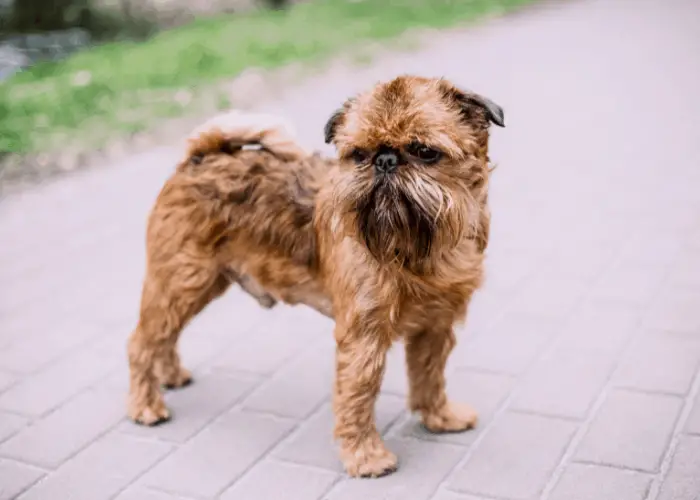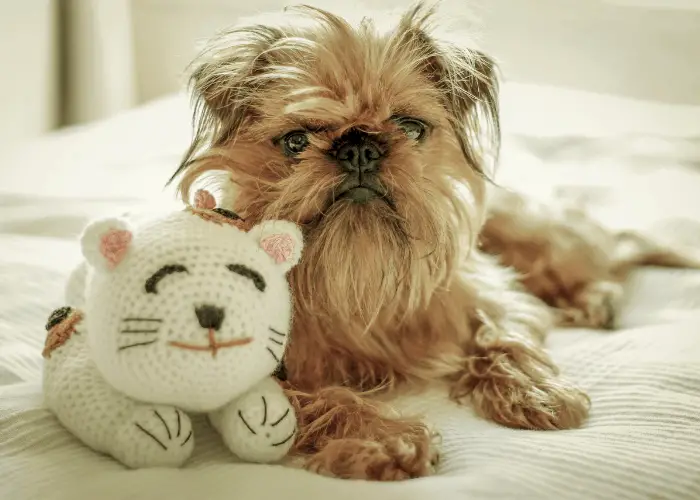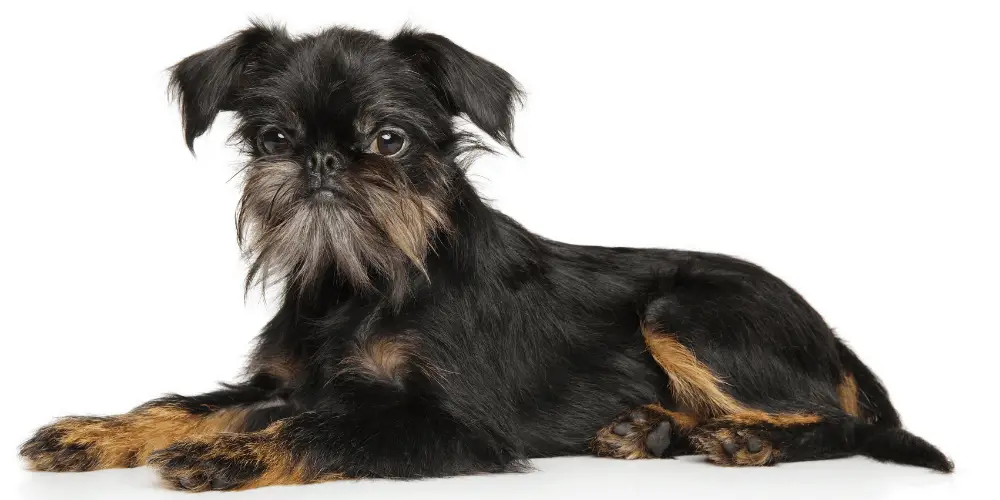- Name: Brussels Griffon
-
Other names: Griffon Bruxellois, Belgium Griffon, Petit Brabançon, Griffon, Griff, Bruss
-
Origin: Belgium
-
Size Type: Small
-
Breed Group: Toy dog breeds (AKC)
-
Life span: 12 -15 years
-
Temperament: Alert, Companionable, Sensitive, Watchful, Inquisitive, Self-important
-
Height: Female: 18-20cm Male: 18-20cm
-
Weight: Female: 2.5-5.5kg Male: 2.5-5.5kg
-
Colors: Black, Red, Belge, Blue, Brown, Black & Tan
-
Puppy Price: Average: $1800 – $2800 USD
Overview

An intelligent breed of toy dog with oodles of personality and an almost human expression, the Brussels Griffin dog makes for a wonderful pet and companion. The breed originated in Brussels, Belgium, and that’s why many breeders also call it Griffon Bruxellois. There are 3 distinct varieties to choose from:
- Griffon Bruxellois
- Griffon Belge
- Petit Brabangon
While all three falls under the Brussels Griffin dog breed, the difference lies in the color and texture of their coat.
This is a sturdy dog with an almost too-flat face, wide-set eyes, and a prominent chin. In fact, the unique facial structure of the dog has often been compared to the Ewoks of Star Wars movies, though this small breed is far more cuddly and cute.
The breed is well-known fonts athletic disposition and high energy levels, often excelling at obedience, performance, and agility sports.
While the Griffon may get along with other pets, including other dogs and cats, they are notorious for being irritable and aggressive around rowdy kids.
However, don’t be afraid to bring a puppy home if you long for a small, easy manage & Ione-man dog’, because a Griffon will always be loyal and utterly affectionate towards a chosen master in a family.
Body Type

The Griffin is sturdy with a large, round head and a stout built. It has a short muzzle, which makes the dog prone to over-heating and sometimes even drooling.
Other characteristics are a domed forehead, an overbite, and wide-set black eyes with high semi-erect ears. It’s up to the owner to either leave the ears natural or have them cropped. The high tail is often docked to leave only one-third the length.
WHAT OTHER BREEDS OF DOGS GET THEIR EARS CROPPED?
However, keep in mind that both tail dockings and cropping of the ears are illegal throughout Europe, though allowed in most other countries.
The dog is about 8 inches in height and can weigh anywhere between 6 and 12 pounds (or 2.5 to 6 kg). This is an athletic, heavy-set dog that will require regular walks to stay in good health.
Coat

The Brussels Griffin dog comes in 2 coat varieties — Smooth and Rough.
Dogs with a rough coat require more grooming and care for the wiry, dense fur. These dogs have more hair around the chin, eyes, and cheeks, and even the fur covering the body is never silky to touch.
That’s precisely the reason why they require more grooming or the wiry coat starts to look untidy and shabby. On the other hand, dogs with a smooth, glossy, tight, and short coat are easier to maintain and also known as the Petit Brabangon variety. Both varieties of the Griffin are prone to shedding.
Color

The Brussels Griffons come in 4 common colors.
- Red — Rather a reddish-brown mixed with a little black around the chin and whiskers
- Black & Tan — Black coat with uniformly distributed reddish-brown spots that appear above the eyes, ears, chin, legs, and rear
- Black —An all-black coat with no distinctive spots in any other color
- Belge —A mix of brown and black, with the black being more prominent around the face
An older Griffons dog can begin to have a gray muzzle, though hair covering the rest of the body rarely becomes white with age.
Temperament

The Griffon is a loyal, affectionate dog with a lot of pride. However, the dog can become aggressive or prone to separation anxiety without proper handling and obedience training.
This is why it’s extremely important to socialize the puppy right from the start and encourage the dog to become independent, alert, and inquisitive, as those are the true characteristics of a good dog.
A great family dog, the Griffon, will bond easily with the humans in the family but are not known to be a very gentle, patient breed.
Rather unpredictable at times, Griffons will not tolerate little children who like to tease the dog or other larger dogs around and will immediately try to assert their dominance through acts of aggression, despite their relatively small size.
This is an intelligent and cheerful dog that requires a strict yet loving handler. The breed is prone to become overly sensitive, moody, and high-strung, and that’s where adequate physical exercise and regular obedience training comes into play.
- Good with Kids
- Cat Friendly
- Dog Friendly
- Trainability
- Shedding
- Watchdog
- Intelligence
- Grooming
- Popularity
- Adaptability
- Hypoallergenic: Yes
*Important Things To Remember*

Griffons can be either greedy or picky eaters. Therefore, establishing good eating habits right from the start is extremely important. While the ideal diet for your dog will depend on age, size, and activity level, it’s best to give your pet A cup of good quality dog food twice a day.
Do not leave food out all the time, as this can encourage poor eating habits in this strong-willed breed. Rather, get your dog accustomed to being fed only twice a day and try to follow the same feeding time and routine every day.
Is the Brussels Griffons dog the right breed for you?
Since this is a small active breed, it makes for a perfect apartment dog. A Griffon can be a worthy companion, especially if you aren’t a first-time dog owner and are well aware of the challenges of house training and obedience training a dog.
However, keep in mind that this breed will demand a lot of time and affection and has a life expectancy of around 12-15 years.


